Review of the D-Link 10G/2.5G DMS-106XT Switch
Remember when buying a network switch was something you did because it was needed for work? Or because you needed to catch a network together for a client and had to explain for what felt like the millionth time the difference between a switch and a router? That seems so long ago. The benefits and understanding of network switches have come a long, long way and in 2022, it is surprisingly normal for a home user to have a 5-8 Port switch hiding somewhere in their home, largely down to the necessity of internet connectivity combined with WiFi coverage being finite. Into this more home and prosumer friendly buyers market, D-Link launched their new kind of switch, the DMS-106XT. Now, the £130-150 price tag of the D-Link DMS-106XT certainly places it at well over £100 more than the typical bog-standard 5+ port switch in the market right now, but they hope that the sheer unique design, intriguing approach to priority of service and (of course) massive increase in potential bandwidth that this new switch offers will justify that price tag. The DLInk DMS-106XT is a 10GbE and 2.5GbE enabled, 6-Port unmanaged switch that has clearly targetted the modern PC gamer in its aesthetics and appeal, most noticeably from its use of a front-mounted LED panel and utters unique shape. There is certainly more to this router than the typical off-the-shelf-switch in your local eMart, so today I want to review the DMS-106XT and help you decide if it deserves your data!
D-Link DMS-106XT Switch Review – Quick Conclusion
As you can probably guess from my tone throughout this review, I found it pretty tough to fault the D-Link DMS-106XT network switch given its price tag and wide variety of network connectivity. There are a few design choices that are going to split opinion (metal throughout, LEDs, very unconventional shape, etc) but these are quite minor points in the grand scheme of things. The Price tag of this switch for a 10GbE and 2.5GbE switch, even unmanaged, is going to make it damn near irresistible to many buyers and now that it has had some time in the market to increase exposure, availability and reviews, the price tag has become increasingly flexible (arriving as low as £130/$140 in some retailers). D-link could stand to be a little clearer about the turbo mode and it’s advantages with the DMS-106XT and the extent to which those LEDs can actually be customized is pretty weak, but you are clearly getting a sturdy, solid and high-performance piece of kit here. Additionally, with the increase of affordability of 10GbE, as well as 2.5GbE becoming the defacto port to be used with WiFi 6 client hardware, this switch has a much wider audience than it might have had just 2 years ago. A great piece of kit and one I heartily recommend.
| Where to Buy a Product | |||
|
|
    
|

|
VISIT RETAILER ➤ |
 |
    
|

|
VISIT RETAILER ➤ |
 |
    
|

|
VISIT RETAILER ➤ |
 |
    
|

|
VISIT RETAILER ➤ |
D-Link DMS-106XT Switch Review – Packaging & Contents
Unlike a lot of the NAS or DAS systems that I review here on NASCompares, the D-Link DMS-106XT is much more likely to be found on the shelves of your local I.T shop and because of that, the packaging is noticeably louder than many network switches. Instead of the standard brown box packaging, the DMS-106XT switches in a loud and colourful retail sleeve, that is clearly at pains to highlight exactly why it is different from the rest of the duller routers in the market.
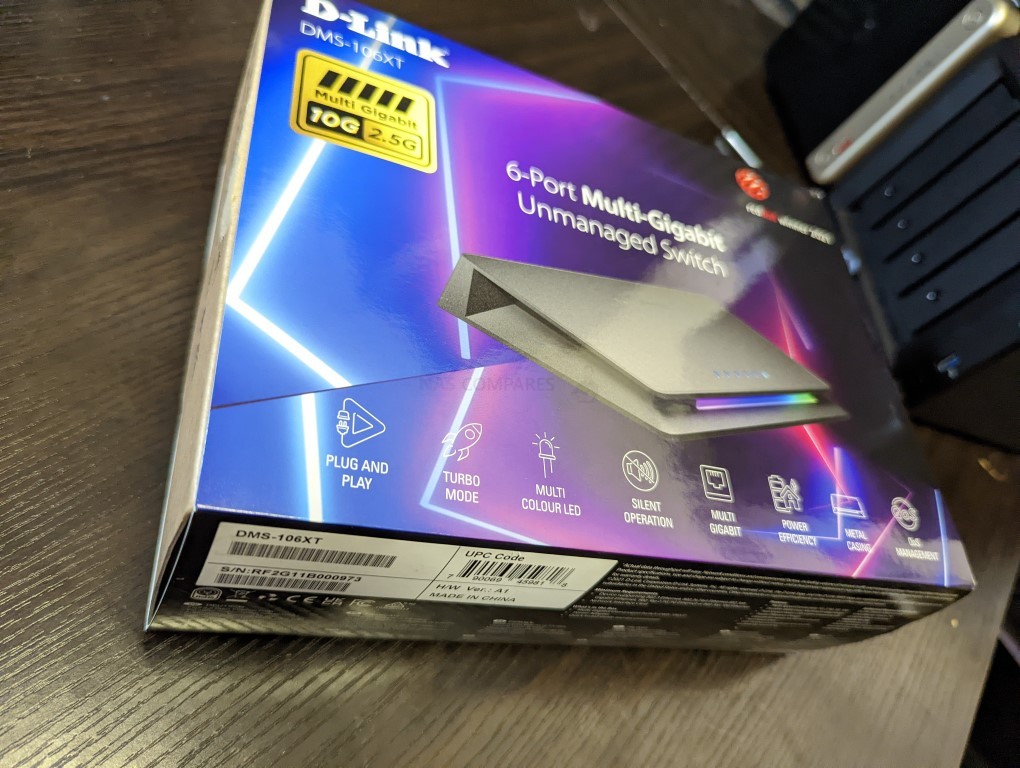
Practically every corner is adorned in loud-n-proud shouts of the switches bandwidth, its turbo mode (we will touch on that later), its LEDs, its zero-noise deployment and also that the router won a Red dot Award for its design at the 2021 event. After years of switches arriving on my desk in brown, uniform and almost shy brown boxes, the D-Link DMS-106XT clearly wants to make alot of a visual impact in the eyes of the consumer. But is the device all sizzle and no sausage?
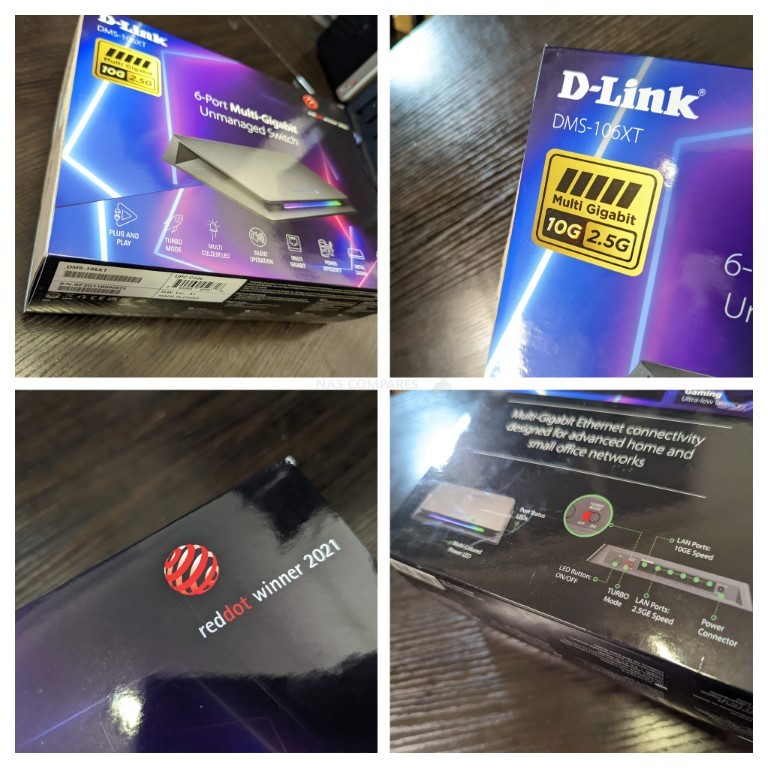
The contents of the D-Link DMS-106XT retail kit are fairly sparse. You get the switch itself, warranty and setup information, an external PSU (with regional clips for UK/EU/US) and that is about it. There are no included RJ45/LAN cables, with is increasingly common with switches these days for reasons of unnecessary wastage. The packaging is a bit flimsy, but the unit itself and the PSU are remarkably sturdy, so I will give them a pass on this.
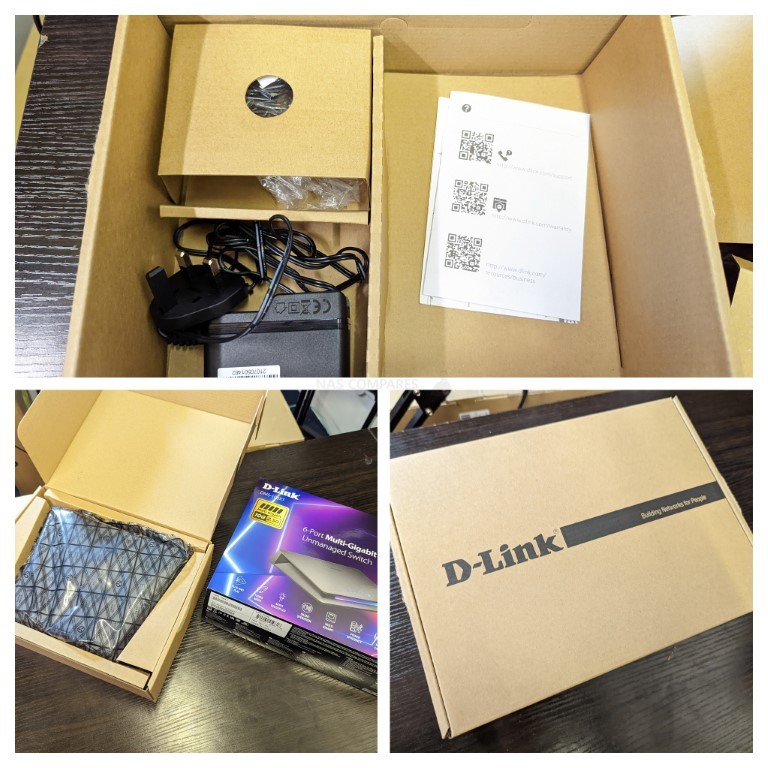
Overall, it’s a fairly regular retail package, in spite of the loud packaging. Let’s discuss the unique design choices that D-Link has made in the DMS-106XT network switch.
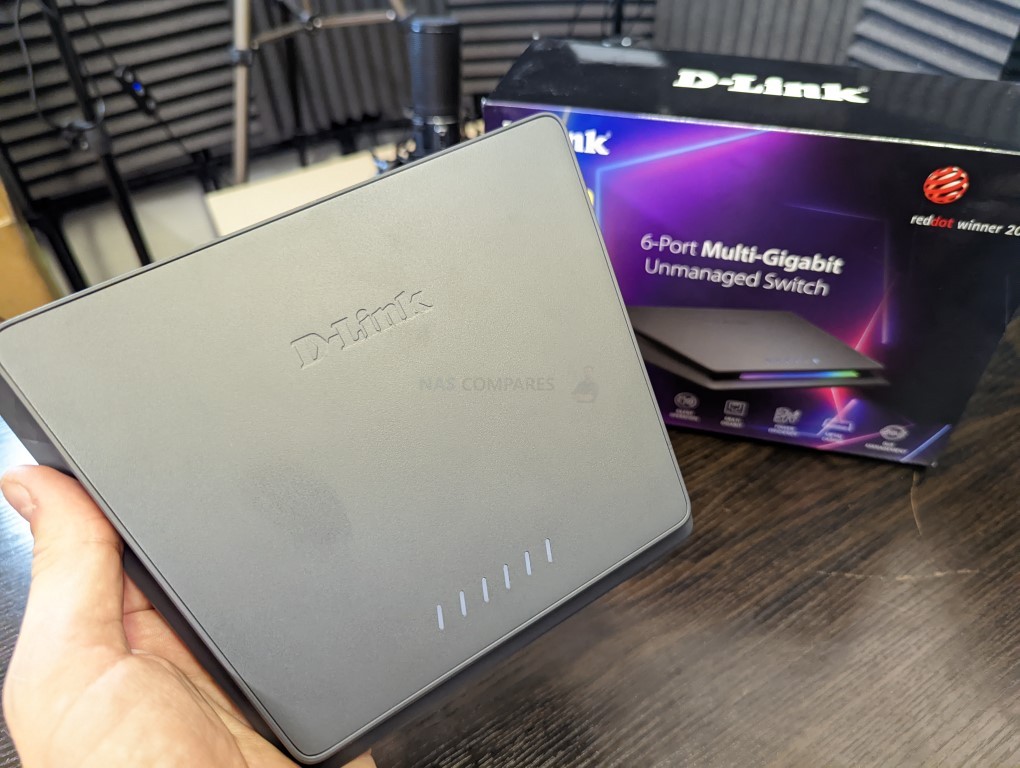
D-Link DMS-106XT Switch Review – Design
Let’s get it out the way early – the D-Link DMS-106XT looks unlike any switch I have ever seen. Looking like a cross between a gamer router and a charging matt, this switch is quick broad in scale but very low in profile. The front and sides of the casing are indented to allow the LED light to travel effectively around the switch when in operation. I am unsure if this assists in any way towards heat dissipation, however, the fact the entire chassis is metal (thereby acting as one giant heatsink) is certainly a great design choice) when you consider that the D-Link DMS-106XT supports up to 45Gbps switching capacity across its 2.5GbE and 10GbE ports. Those internal network controllers are going to get HOT, even for an unmanaged switch.
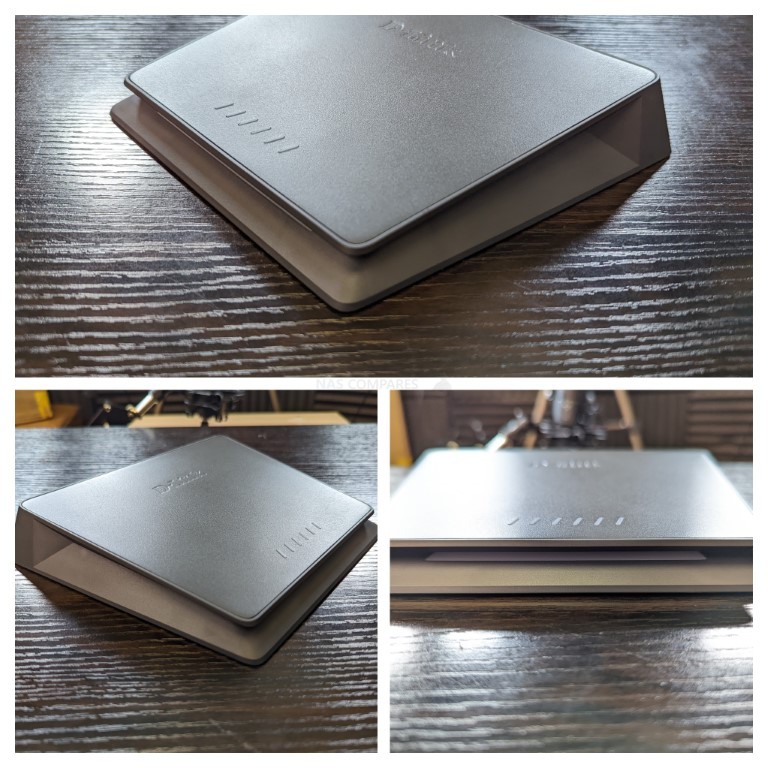
The design of the D-Link DMS-106XT has clearly been approached with a slight space-age/hi-modern attitude in mind. Aside from the unconventional shape, the switch has zero text/identifiers on the LEDs located on the front of the casing. So, alongside the larger RGB LED strip, the DMS-106XT also features six individual LEDs that denote the LAN connections on the rear of the device. The neon blue LED looks great against the grey brushed metal and although it would have been (REALLY) useful to know which port each LED corresponds to, I still applaud the style.
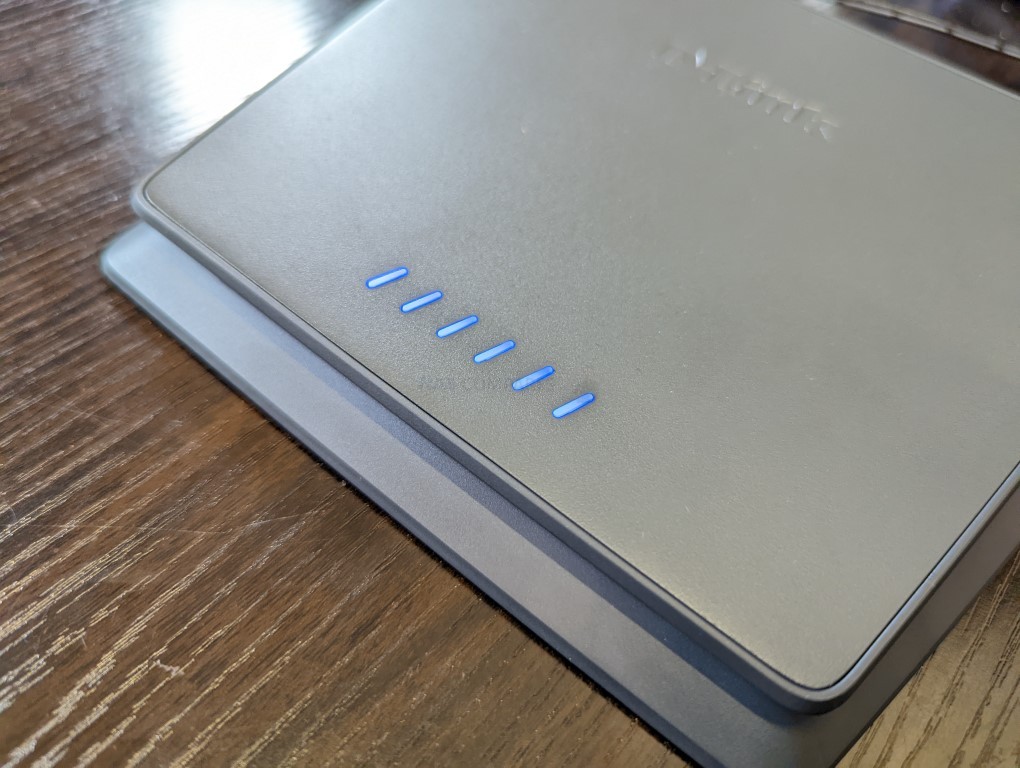
When the switch is being usual in ‘normal’ mode (i.e without Turbo activated), the front LED strip displays a slightly purple/white stripe, which thanks to the angle of the chassis, bounces from the surface of where it is deployed and creates an attractive fade effect. This can be switched off on the rear of the device, but that would seem an odd move when buying a device that has been designed to be THIS focused on its design/style. Nevertheless, I think it’s a shame that you cannot take advantage of the multi-colour LED scheme on the D-Link DMS-106XT unless you use turbo mode.
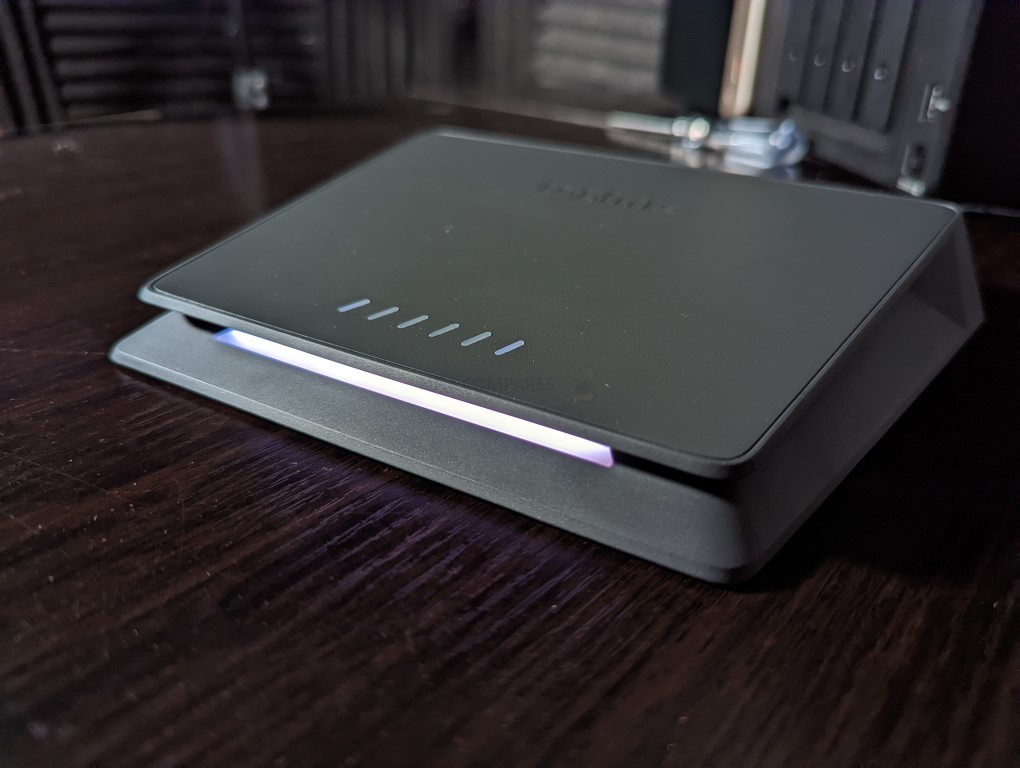
When the Turbo mode of the D-Link DMS-106XT is activated (I WILL get onto what exactly that is later in the article, I promise), the light strip switches to a coloured strip effect. It’s a small detail, but I wish it had the option of different patterns (as found in a number of Seagate Firecuda External storage devices that feature LEDs) such as fade, blink, slow change, horizontal travelling, etc. Having the LEDs here is cool and it certainly doesn’t detract from the bandwidth and abilities of the device, I just hoped the LEDs would be more customizable.
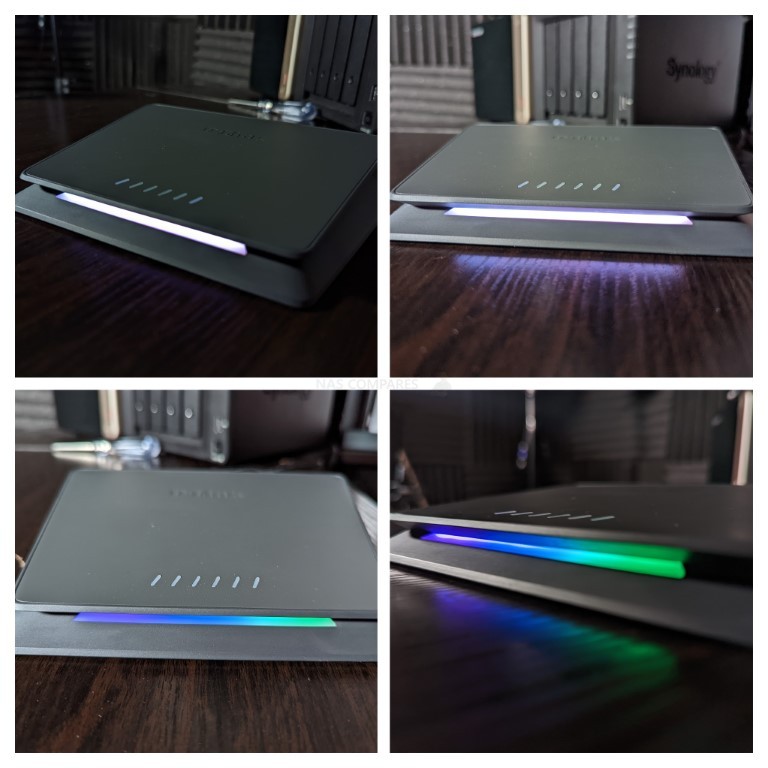
The base of the D-Link DMS-106XT network switch continues with the metal design, as well as large rubberized feet at each corner. I am impressed with the commitment to the design D-Link has made here and I really like how eye-catching the whole thing is – even the base (something many users will never even see after unpacking the device).
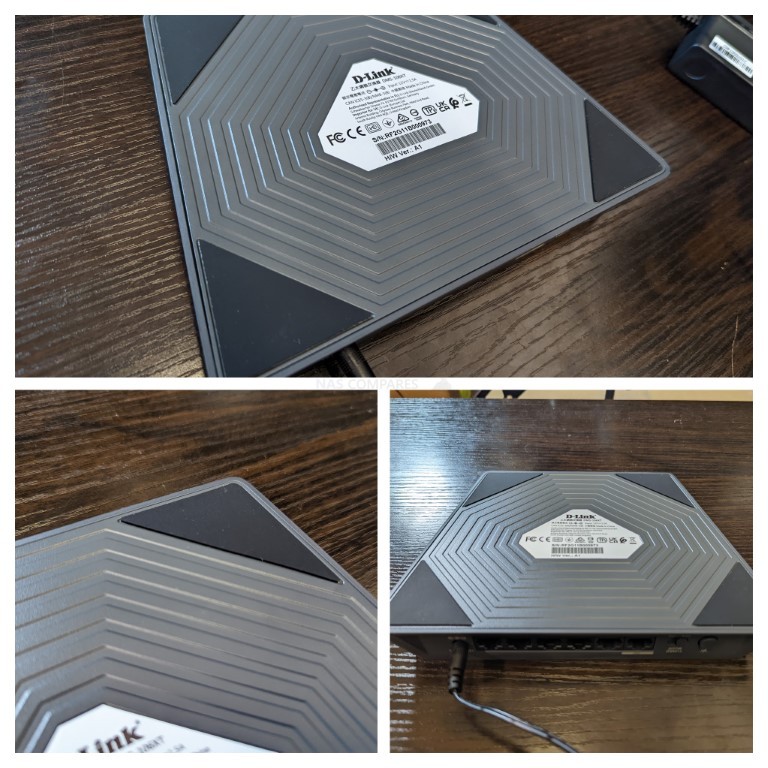
You really cannot fault much of the design of the D-Link DMS-106XT. Aside from the LED/lighting feature being a tad under-used, the rest of the design, shape, heat dissipation and overall feel of this metal chassis is genuinely awesome. Next up, let’s discuss the connections that the DMS-106XT arrives with and talk a little about why this device has the potential to be such a game-changer when compared against network switches in the market right now.
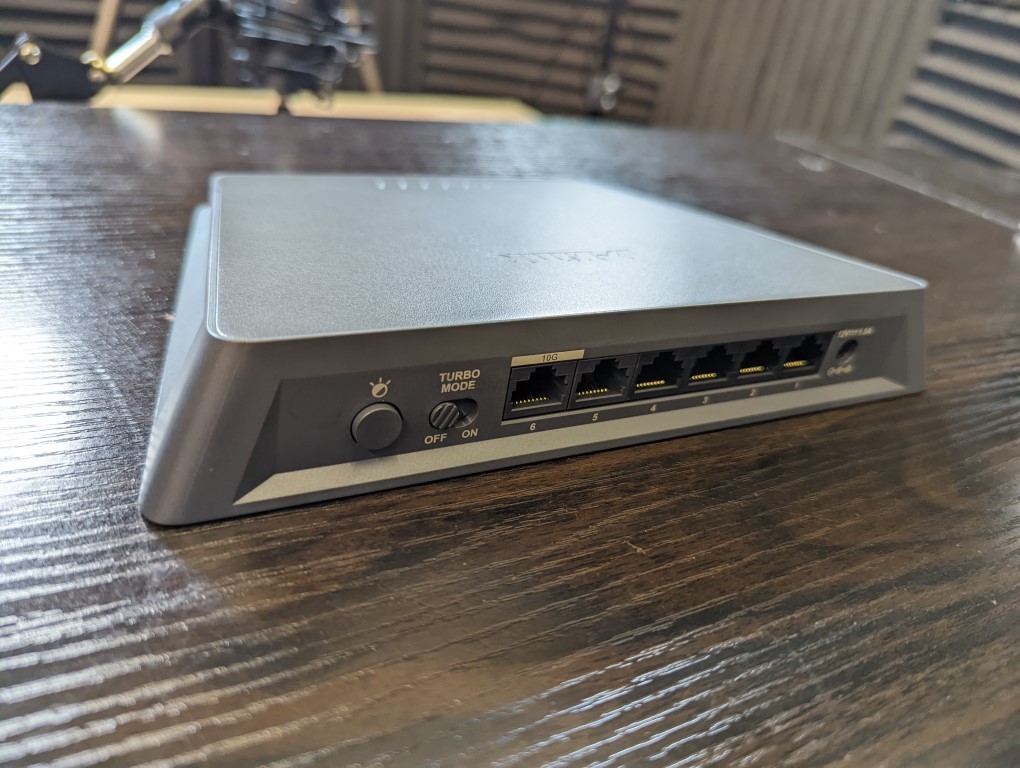
D-Link DMS-106XT Switch Review – Ports and Connections
Unlike a router, the D-Link DMS-106XT switch focuses on those LAN/Network connections. You can certainly feed in an external/Internet connection into one of those ports for the rest of the network to access, but this unmanaged switch is designed to be a secure and efficient negotiation point between the rest of the devices sharing its network. What sets the DMS-106XT apart from many in the market right now is the scale of the bandwidth that it affords to the individual ports, compared with many network switches in the market. Just to put the D-Link DMS-106XT Price Tag into a little perspective. Here is an example of the Network Switch food chain, their prices and where the D-Link DMS-106XT sits between them:
5-8 Port Switches, RJ45/Copper-based Connections + Unmanaged
- $13.99 / £12.99 – TP-Link TL-SG105, 5x 1GbE = 5Gb Bandwidth
- $119 / £108 – QNAP QSW-1105-5T, 5x 2.5GbE = 12Gb Bandwidth
- $139 / £125 – D-Link DMS-106XT, 1x 10GbE and 5x 2.5GbE = 22.5Gb Bandwidth
- $189 / £179 – TRENDnet 8-Port TEG-S380, 8x 2.5GbE = 20Gb/s Bandwidth
- $199 / £179 – Netgear GS110MX, 8x 1GbE and 2x 10GbE = 28Gb/s Bandwidth
As you can see, the D-Link DMS-106XT switch sits vaguely in the middle in terms of its price tag BUT features a huge amount of network bandwidth potential.

The rear of the D-Link DMS-106XT features only 2 buttons/switches and neither of them is the ‘power’. The first one allows you to adjust the LEDs a little. Not massively and is ultimately an on, off and something in the middle, but I can imagine a few users might want to switch those LEDs off (though again, this seems an odd choice to switch to buy and then do this).
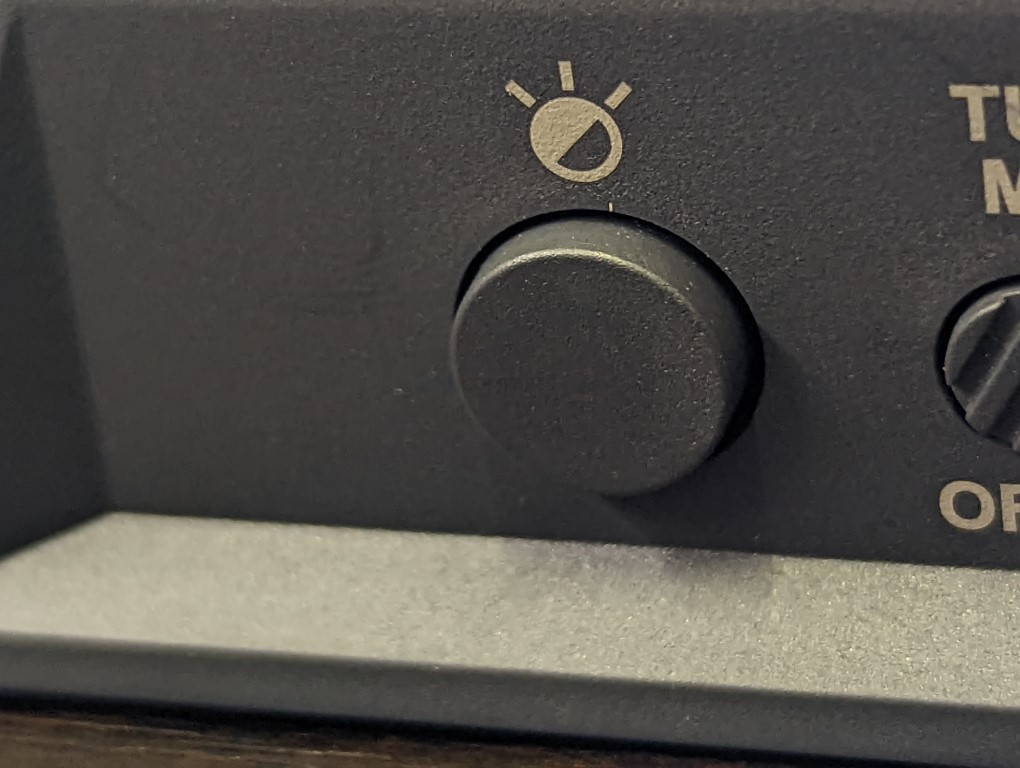
The inclusion of 10GBASE-T (10G, 10GbE, 10-gig or whatever you want to call it) on the D-Link DMS-106XT is a pretty big deal at this price point, as well as in terms of network bandwidth communication. Why would a user want a single 10GbE port on their switch? Perhaps you are running a greater than 1GbE internet connection (you will still need an appropriate router/modem connected between your ISP services and the D-Link DMS-106XT) and want that connection shared between those 2.5GbE connected users. Alternatively, they might want this switch connected to another existing 10GbE network which can then share out the bandwidth to the other 5 ports of this switch (around 2GbE or 200MB/s possibly throughput each at peak). Finally (and one that I personally will be using this switch for) is to connect a 10GbE enabled NAS server from Synology/QNAP and allow client devices on the network to have a greater degree of upload/download at all times. 10GbE is not exactly new, but has become increasingly affordable in recent years. Plus the adoption of 2.5GbE on client hardware (thanks in a big way to WiFi 6 getting more popular) has been slowly increasing and therefore that means these devices can achieve higher connection speeds to the network and other devices. This 10GbE and 2.5GbE switch combination is what sets this switch apart from many in the market at this price point.
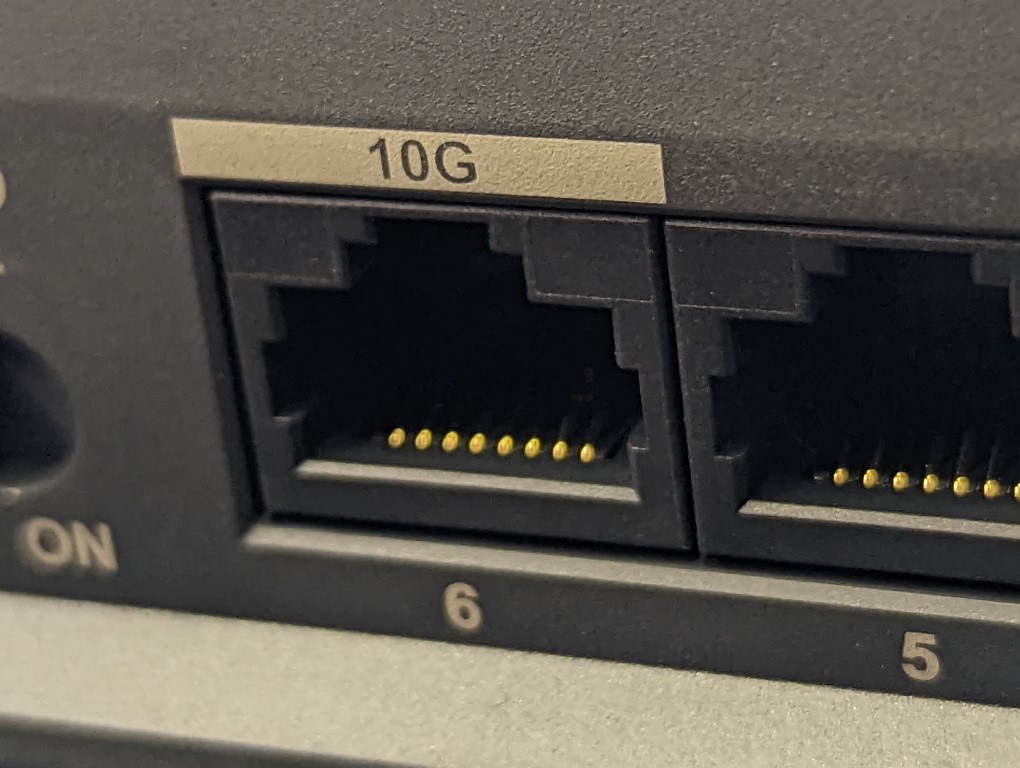
The other 5 ports of the D-Link DMS-106XT switch are 2.5GbE each and (sorry to be a broken record about this) if you look at the price of most 5 port unmanaged 2.5GbE switches in the market from QNAP, TP-Link and TRENDnet, you find that they all arrive at around the $90-130 mark (with relatively unknown brands such as Mokerlink and their 2G050G and 2G080G 5x 2.5GbE switch arriving somewhere in the middle at $110-169). So the D-Link DMS-106XT landing with 5x 2.5Gb AND 10Gb at around the $130 mark seems stupidly good value.
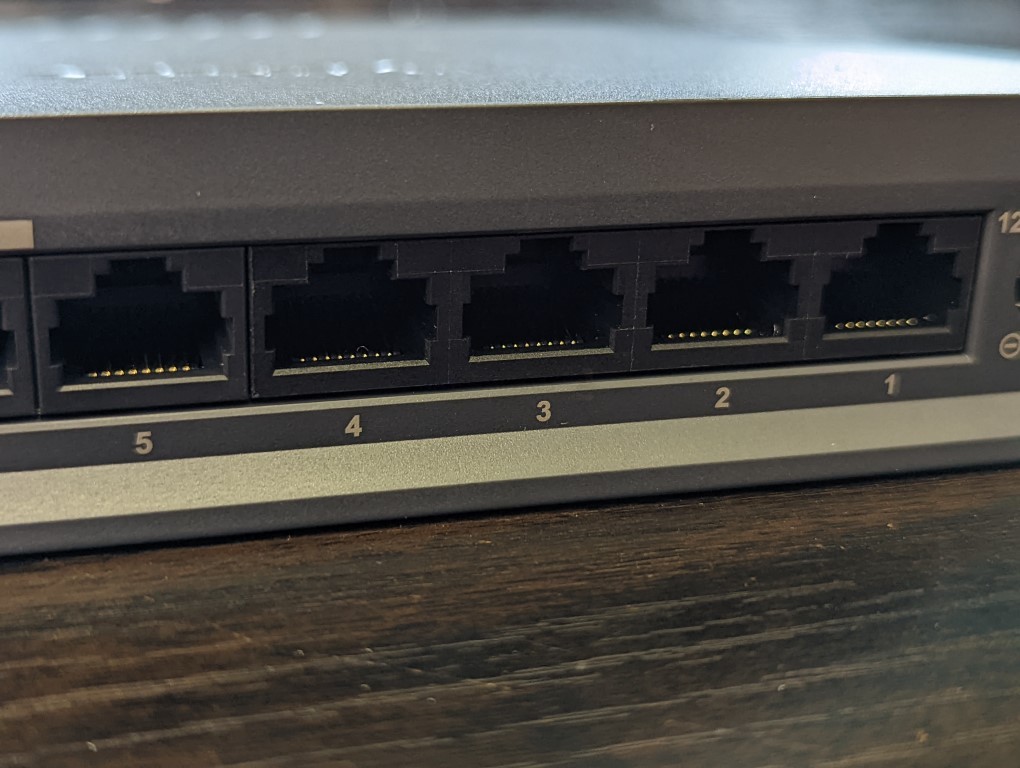
But of course, there is another small but impressive thing about the D-Link DMS-106XT network switch that is not really available on any other unmanaged switch in the market (even the bigger brands). It’s time to have a little chat about ‘Turbo mode’.
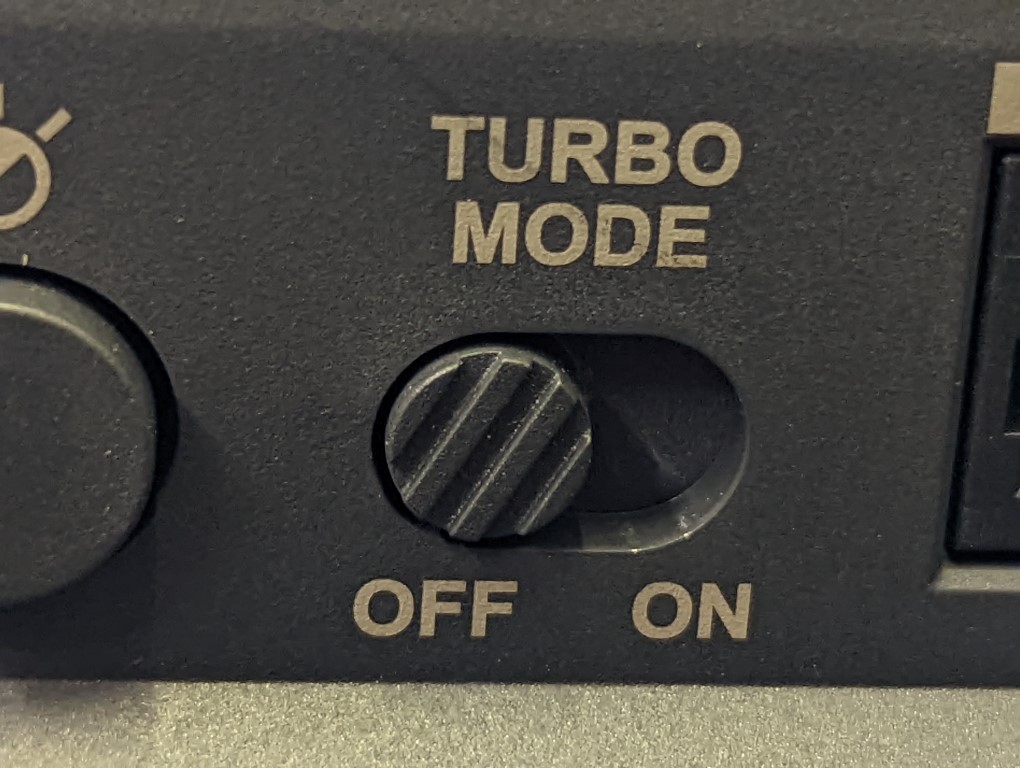
D-Link DMS-106XT Switch Review – Turbo Mode
I think it would be reasonable to say that when it comes to hardware (network, desktop, day-to-day), many brands have a tendency to lean on certain ‘buzz’ terms to promote their product or make it stand out from their competitors (anyone else remember SEGA’s ‘blast processing’ of the 90s?). In the case of the D-Link DMS-106XT, when I saw they were making a song-and-dance of their switches ‘turbo mode’, I was IMMEDIATELY suspicious. I erroneously assumed this was just marketing jargon/bumpf to switch the LEDs into different patterns. This is after all an ‘unmanaged switch’ and therefore that implies that all data packet handling on the network was going to be handled to a default set of rules/protocols. However, no, Turbo Mode on the D-Link DMS-106XT is legitimately something useful. When activated, it tells the system to institute an immediately (but predefined) set of Priority of Service (PoS) rules across the physical ports of the system, This means that devices plugged into specific ports will be treated as the most important devices in the network and their network bandwidth/connectivity takes priority (i.e if they need the FULL current bandwidth towards another device on the network or connected system on the switch, they override everyone else. So, for VoIP phone lines, Surveillance networks, IPTV services and (of course) professional gaming/eSports, you can ensure that another device on the network suddenly needed to download a heft windows update or streaming 4K Netflix will not affect your mission-critical services.
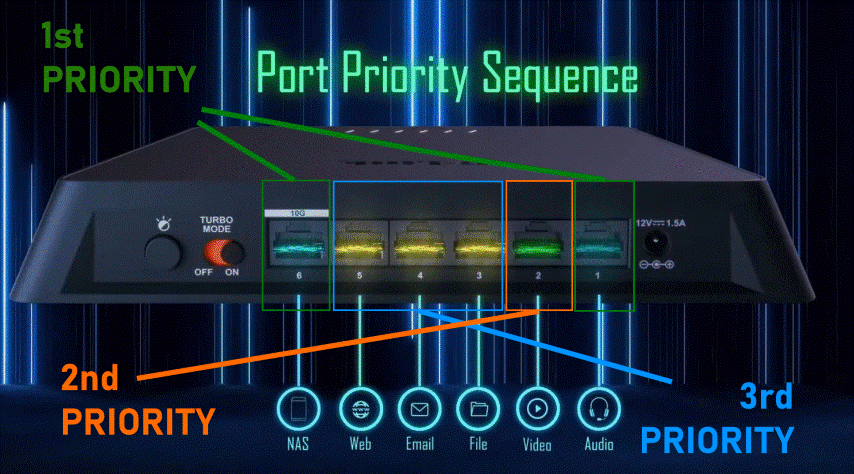
As you can see from the diagram above, the 10GbE and one of the 2.5GbE ports are Priority #1 in Turbo mode, a second 2.5GbE port is Priory #2 and the remaining three 2.5G ports are Priority #3. Now, on the face of it, this may seem incredibly rudimentary and hardly something to really care about. However, you need to take a small step back and remember that this is an UNMANAGED switch (and priced accordingly). If you were to opt for a MANAGED switch that had this combination of 1x 10G + 5x 2.5G, it would easily add about $100 to the price tag. Managed switches do give you many more services (customizable PoS options, Quality of Service, vLAN creation, Port-Trunking, etc), however, if you only considered a smart/managed switch because you wanted to ensure that 1-2 devices had PoS in the network, the D-Link DMS-106XT is one of very, very few unmanaged switches that still provides this service.
D-Link DMS-106XT Switch Review – Conclusion
As you can probably guess from my tone throughout this review, I found it pretty tough to fault the D-Link DMS-106XT network switch given its price tag and wide variety of network connectivity. There are a few design choices that are going to split opinion (metal throughout, LEDs, very unconventional shape, etc) but these are quite minor points in the grand scheme of things. The Price tag of this switch for a 10GbE and 2.5GbE switch, even unmanaged, is going to make it damn near irresistible to many buyers and now that it has had some time in the market to increase exposure, availability and reviews, the price tag has become increasingly flexible (arriving as low as £130/$140 in some retailers). D-link could stand to be a little clearer about the turbo mode and it’s advantages with the DMS-106XT and the extent to which those LEDs can actually be customized is pretty weak, but you are clearly getting a sturdy, solid and high-performance piece of kit here. Additionally, with the increase of affordability of 10GbE, as well as 2.5GbE becoming the defacto port to be used with WiFi 6 client hardware, this switch has a much wider audience than it might have had just 2 years ago. A great piece of kit and one I heartily recommend.
| PROS | CONS |
|
|
| If you are looking for the D-Link DMS-106XT, Availability is a little thin. Below are links to where to find it on Amazon and NASCompares gets an associates fee for every purchase:
Amazon U.S – HERE Amazon UK – HERE Amazon DE – HERE Amazon CA – HERE |
🔒 Join Inner Circle
Get an alert every time something gets added to this specific article!
This description contains links to Amazon. These links will take you to some of the products mentioned in today's content. As an Amazon Associate, I earn from qualifying purchases. Visit the NASCompares Deal Finder to find the best place to buy this device in your region, based on Service, Support and Reputation - Just Search for your NAS Drive in the Box Below
Need Advice on Data Storage from an Expert?
Finally, for free advice about your setup, just leave a message in the comments below here at NASCompares.com and we will get back to you. Need Help?
Where possible (and where appropriate) please provide as much information about your requirements, as then I can arrange the best answer and solution to your needs. Do not worry about your e-mail address being required, it will NOT be used in a mailing list and will NOT be used in any way other than to respond to your enquiry.
Need Help?
Where possible (and where appropriate) please provide as much information about your requirements, as then I can arrange the best answer and solution to your needs. Do not worry about your e-mail address being required, it will NOT be used in a mailing list and will NOT be used in any way other than to respond to your enquiry.

|
 |
The BEST NAS of 2026.... ALREADY??? (UnifyDrive UP6)
How Much RAM Do You Need in Your NAS?
A Buyer's Guide to Travel Routers - GET IT RIGHT, FIRST TIME
Jonsbo N6 DIY NAS Case Review
The Best Bits (and Worst Bits) of NAS of 2025!
Minisforum MS-02 Ultra Review
Access content via Patreon or KO-FI





Discover more from NAS Compares
Subscribe to get the latest posts sent to your email.


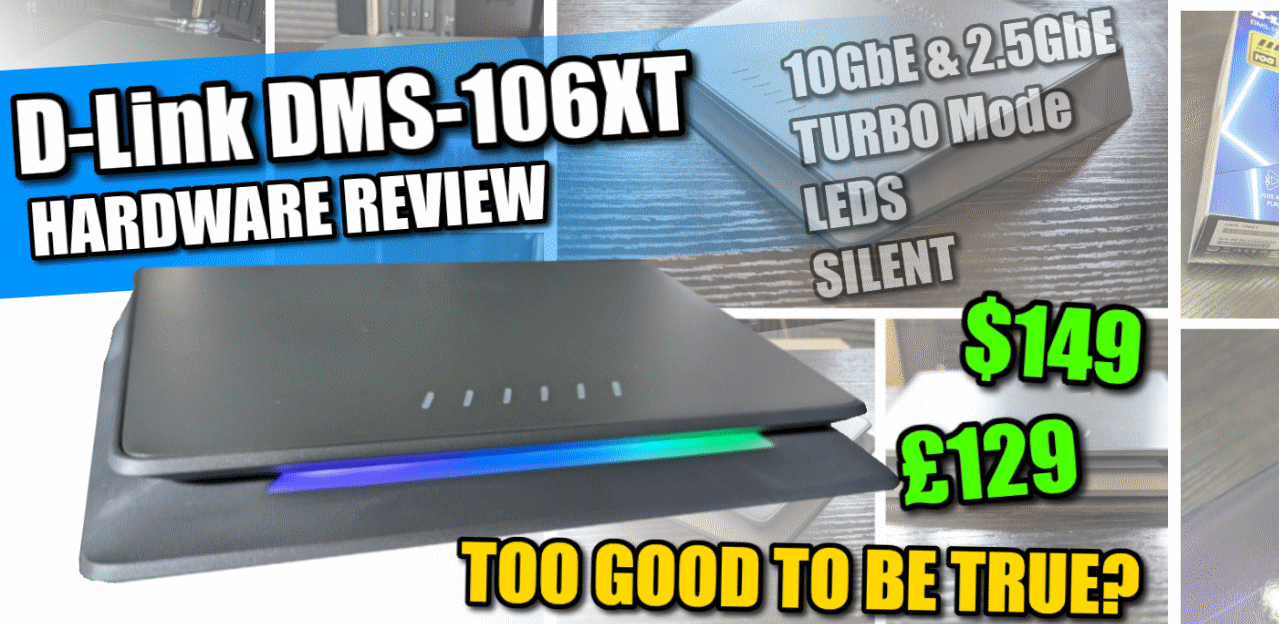



My router is 10gb and my nas is 10gb why it will not switch to 2 10gb port
REPLY ON YOUTUBE
New to networking, but this Seems kind of odd, I would think you would want the 10gb for file transfers, so it should be low prio?
REPLY ON YOUTUBE
The lack of cpu power is terrible.
4600mbits real life throughput is dismal.
The fact that if only two pc are connected at 2.5gbps, one pc send packets at 2500mbps Than the other pc can only receive at 2100mbps becuase the backplane is shite
REPLY ON YOUTUBE
you missed an R in review @0:57
REPLY ON YOUTUBE
Asustor Flashtor 6 FS6706T – 6-bay
REPLY ON YOUTUBE
I have this thing but when it’s too hot inside my house you can’t barely touch it or you burn your fingers. I have it constantly running with a fan outside. Second thing i don’t like, it is malfunctioning when it’s getting too hot, connections will be lost that easy so that’s why i have it constantly running with an outside fan, then there is nothing wrong with it: running fast and smooth.
REPLY ON YOUTUBE
I hate seaguls lol
REPLY ON YOUTUBE
The switch prices in your location are really cheap. $130 for that? In Canada it is $330 at Amazon, $600 at Newegg.
REPLY ON YOUTUBE
On the D-Link DMS 106XT Unmanaged Switch: could i run it contineously on Turbo Mode?
REPLY ON YOUTUBE
So, can you use the 10gbe port for as uplink to your router and the other ones for devices?
REPLY ON YOUTUBE
I have one of these and the only thing i feel leaves me wanting is the ability to RUN it off PoE. I have a managed switch infront of it with PoE capabilities and i would have loved to be able to run it off that for a cleaner setup. There are PoE splitters that could solve this issue but i’ve yet to find any that support over gigabit speeds so it would depend on the setup of the rest of your network.
REPLY ON YOUTUBE
Sooo im probably being an idiot here but what’s the use for a 10gb port if there’s only 1 port, wouldn’t you need atleast 2 to make use of it?
REPLY ON YOUTUBE
Well done. I would prefer a normal case – you can stack things on top … and all six 10 Gbps ports
REPLY ON YOUTUBE
Get to the point LOL
REPLY ON YOUTUBE
Read the title wrong and assumed this crazy looking thing was a router.
REPLY ON YOUTUBE
The QNAP QSW-2104-2T is better for 160 EURs, 2 full 10GB ports and 4 2.5GB ports with a total of 6 ports and 60Gbps switch capacity, and as a bonus doesn’t look like a party RGB spaceship.
REPLY ON YOUTUBE
Funny that managed switches are actually unmanaged by the oem and unmanaged switches are actually managed by the oem
REPLY ON YOUTUBE
Why not 2 10gbe? I just want to connect a nas and pc via 10gbe and have the rest at gigabit, why is that so hard for manufacturers to understand.
REPLY ON YOUTUBE
Bought two of these switches recently to upgrade my home network from gigabit to 2.5GbE. The main reason I chose this switch was that this was the only one available that had both the ethernet ports and power connector on the back of the unit, which suited my setup far better.
REPLY ON YOUTUBE
“sales wanking” – great description.
REPLY ON YOUTUBE
or just go with mikrotik 8 port 10 Gb as a cheap alternative
REPLY ON YOUTUBE
You do an outstanding job…your reviews a excellent…. BUT… You don’t have to say you hate seagulls…we all know…and rarely heard….they add a little lightness of being ????. ????????????
REPLY ON YOUTUBE
I hate seagulls too.. and also 2.5Gbps.. 😛 If you have to buy new NICs and new switches to go to 2.5Gbps anyway, if you can afford it why not just go for 10Gbps? The prices are coming down for 10Gbps and will eventually be cheaper (I know the price difference is the main argument *_NOW_* ). When you factor the speeds of modern SSDs, the network is becoming a huge bottleneck and even 10Gbps is already slower than a modern NVMe drive. Go straight to 10Gbps if you can you won’t regret it, 2.5Gbps would have been nice 10 years ago….
REPLY ON YOUTUBE
If you film in the dark, the seagulls can’t find you.
REPLY ON YOUTUBE